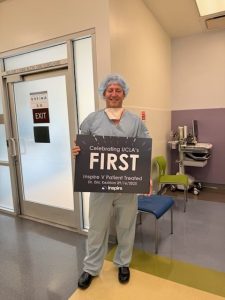 Hypoglossal nerve stimulation has been a major breakthrough in the treatment of obstructive sleep apnea for patients unable to tolerate positive airway pressure therapy. Inspire Medical Systems had the first technology approved by the US Food and Drug Administration in 2014, and I was the first surgeon in the Western United States to offer this treatment after the approval. From its beginning, Inspire’s system (Upper Airway Stimulation) utilized both a stimulation lead and respiratory sensing lead. The stimulation lead allowed the delivery of electrical stimulation from the pulse generator (the pacemaker-type device in the chest) to the nerve that controls tongue movement (hypoglossal nerve) in the neck. The sensing lead monitored breathing patterns so that the stimulation was delivered when it was most needed: starting right before the start of breathing in (inspiration) and continuing through inspiration.
Hypoglossal nerve stimulation has been a major breakthrough in the treatment of obstructive sleep apnea for patients unable to tolerate positive airway pressure therapy. Inspire Medical Systems had the first technology approved by the US Food and Drug Administration in 2014, and I was the first surgeon in the Western United States to offer this treatment after the approval. From its beginning, Inspire’s system (Upper Airway Stimulation) utilized both a stimulation lead and respiratory sensing lead. The stimulation lead allowed the delivery of electrical stimulation from the pulse generator (the pacemaker-type device in the chest) to the nerve that controls tongue movement (hypoglossal nerve) in the neck. The sensing lead monitored breathing patterns so that the stimulation was delivered when it was most needed: starting right before the start of breathing in (inspiration) and continuing through inspiration.
There have been some technical and technological challenges with the sensing lead. Inspire has addressed these, including redesigning the sensing lead. Some challenges are harder to address, such as the one I described in last month’s post about migration of the Inspire IV sensing lead years after surgical placement.
With extensive research and development, Inspire has worked to integrate the sensing functionality into the pulse generator with the introduction of the Inspire V system. The Inspire V system no longer requires a separate sensing lead, as the pulse generator can monitor the breathing pattern and deliver the electrical stimulation at the right time through the stimulation lead (the system still does require the stimulation lead). Inspire has performed rigorous testing and also used this system in a few centers around the world, with both showing that the system works just as well as the Inspire IV system, with the benefit of avoiding the time and risks of having the additional stimulation lead. From a surgical standpoint, one small but nice difference is that the Inspire V system provides a little more flexibility and ease in where we place the chest incision for the pulse generator, as it can be placed closer to the shoulder where it is not as visible (nice for both women and men). There are some other improvements with the Inspire V system, including more options for the sleep medicine team to improve the system programming and patient comfort and monitoring.
Any new technology requires careful review by an institution. I am pleased to report that UCLA has completed this process. With UCLA’s approval in place, we have already scheduled patients for implantation with the Inspire V system in the weeks ahead. We look forward to continuing to offer the latest proven technologies to our patients with obstructive sleep apnea.





5 + 5 =